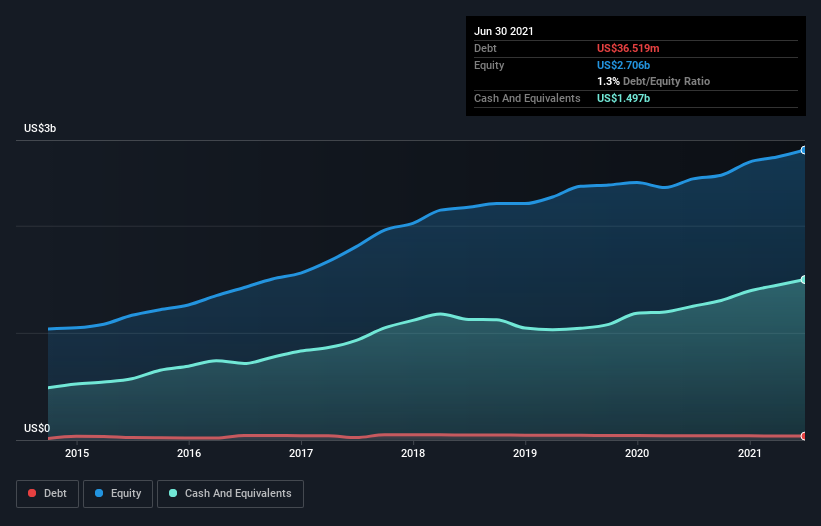IPG Photonics (NASDAQ:IPGP) Has A Rock Solid Balance Sheet
Some say volatility, rather than debt, is the best way to think about risk as an investor, but Warren Buffett famously said that 'Volatility is far from synonymous with risk.' So it might be obvious that you need to consider debt, when you think about how risky any given stock is, because too much debt can sink a company. We note that IPG Photonics Corporation (NASDAQ:IPGP) does have debt on its balance sheet. But the real question is whether this debt is making the company risky.
Why Does Debt Bring Risk?
Generally speaking, debt only becomes a real problem when a company can't easily pay it off, either by raising capital or with its own cash flow. If things get really bad, the lenders can take control of the business. While that is not too common, we often do see indebted companies permanently diluting shareholders because lenders force them to raise capital at a distressed price. Of course, debt can be an important tool in businesses, particularly capital heavy businesses. The first step when considering a company's debt levels is to consider its cash and debt together.
Check out our latest analysis for IPG Photonics
What Is IPG Photonics's Net Debt?
The image below, which you can click on for greater detail, shows that IPG Photonics had debt of US$36.5m at the end of June 2021, a reduction from US$39.8m over a year. But on the other hand it also has US$1.50b in cash, leading to a US$1.46b net cash position.
How Strong Is IPG Photonics' Balance Sheet?
Zooming in on the latest balance sheet data, we can see that IPG Photonics had liabilities of US$255.9m due within 12 months and liabilities of US$124.3m due beyond that. On the other hand, it had cash of US$1.50b and US$257.7m worth of receivables due within a year. So it can boast US$1.37b more liquid assets than total liabilities.
This short term liquidity is a sign that IPG Photonics could probably pay off its debt with ease, as its balance sheet is far from stretched. Simply put, the fact that IPG Photonics has more cash than debt is arguably a good indication that it can manage its debt safely.
On top of that, IPG Photonics grew its EBIT by 52% over the last twelve months, and that growth will make it easier to handle its debt. There's no doubt that we learn most about debt from the balance sheet. But ultimately the future profitability of the business will decide if IPG Photonics can strengthen its balance sheet over time. So if you want to see what the professionals think, you might find this free report on analyst profit forecasts to be interesting.
Finally, a company can only pay off debt with cold hard cash, not accounting profits. While IPG Photonics has net cash on its balance sheet, it's still worth taking a look at its ability to convert earnings before interest and tax (EBIT) to free cash flow, to help us understand how quickly it is building (or eroding) that cash balance. During the last three years, IPG Photonics produced sturdy free cash flow equating to 72% of its EBIT, about what we'd expect. This cold hard cash means it can reduce its debt when it wants to.
Summing up
While we empathize with investors who find debt concerning, you should keep in mind that IPG Photonics has net cash of US$1.46b, as well as more liquid assets than liabilities. And we liked the look of last year's 52% year-on-year EBIT growth. So we don't think IPG Photonics's use of debt is risky. When analysing debt levels, the balance sheet is the obvious place to start. But ultimately, every company can contain risks that exist outside of the balance sheet. For example - IPG Photonics has 1 warning sign we think you should be aware of.
If, after all that, you're more interested in a fast growing company with a rock-solid balance sheet, then check out our list of net cash growth stocks without delay.
This article by Simply Wall St is general in nature. We provide commentary based on historical data and analyst forecasts only using an unbiased methodology and our articles are not intended to be financial advice. It does not constitute a recommendation to buy or sell any stock, and does not take account of your objectives, or your financial situation. We aim to bring you long-term focused analysis driven by fundamental data. Note that our analysis may not factor in the latest price-sensitive company announcements or qualitative material. Simply Wall St has no position in any stocks mentioned.
Have feedback on this article? Concerned about the content? Get in touch with us directly. Alternatively, email editorial-team (at) simplywallst.com.

